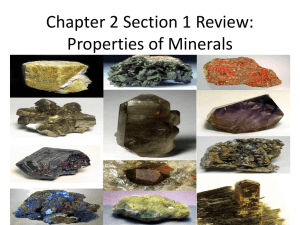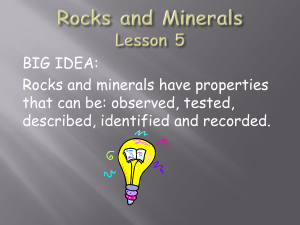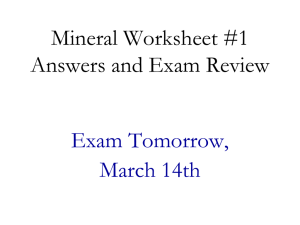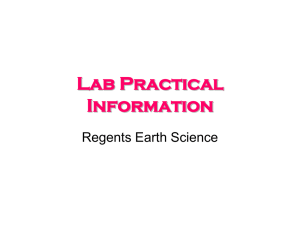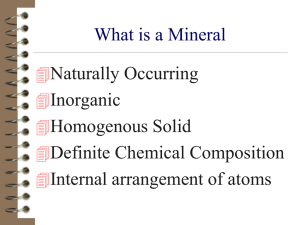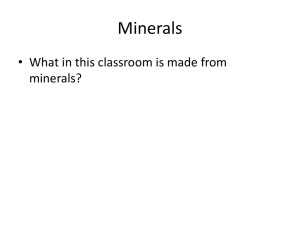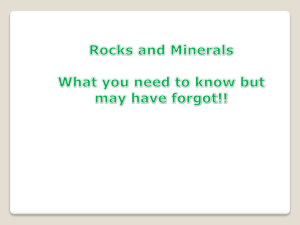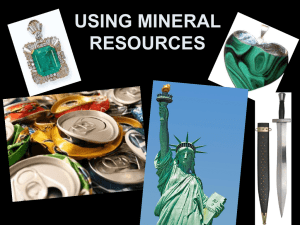Mineral Detective Lab - mrs. villarreal`s orange team science
advertisement
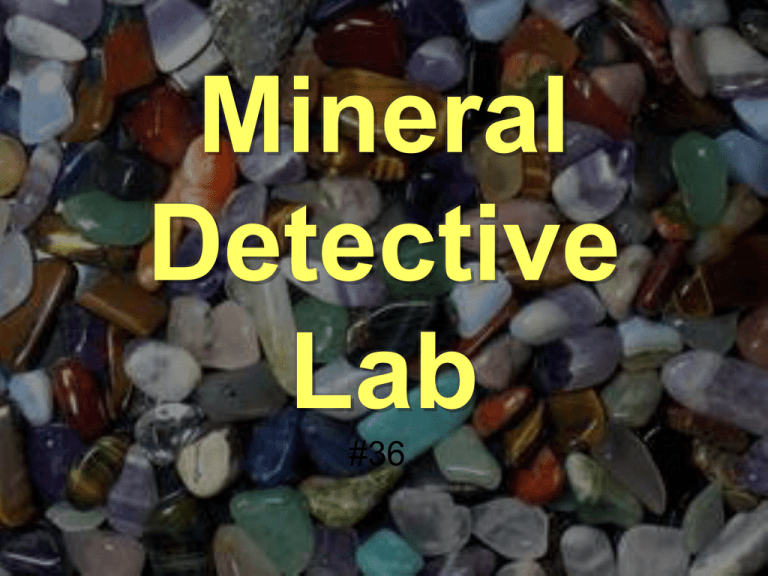
Mineral Detective Lab #36 Purpose of Lab • To learn how to use mineral identification techniques to identify unknown minerals. • To become more familiar with some common minerals. • To review the parts of a laboratory experiment and report. Lab Timeline • MONDAY: Introduction of Formal Lab, break into pairs, write Title, Introduction, Hypothesis, Materials, Procedures, “Observations” column • TUESDAY: In pairs, complete “Light Interaction”, “Smell,” and “Streak,” • WEDNESDAY: Mohls Hardness Scale, Set up Solubility Tests • THURSDAY: “Cleavage,” “Ice,” Finish observations for “Solubility” • FRIDAY: Use information to identify minerals, write conclusion paragraph. MONDAY #36 On a blank sheet of paper… • Your paper will have the following sections: – – – – – – Title Introduction Paragraph Materials Procedures ( just write “See Lab Instructions”) Results (This will be the completed data table) Modified Conclusion Title and Introduction • Name, date, period, #36 in the upper right hand corner. • Write “Mineral Detective Lab” across the top. • On the first line, write “Partner(s): ________” • Skip a line and write “INTRODUCTION” • Please take 5 minutes to write ONE paragraph that answers these questions… – What is the purpose of this lab? – Why is the information learned in this lab important? – Who could benefit from this information? Materials • Skip a line and write “MATERIALS.” • Remember that to earn full credit, EACH material must have both an amount and a size (if applicable.) • Create a bulleted list that includes the following: – 1 small Magnifying glass – 8 different small mineral specimens – 1 Penny – 1 small Streak plate – 1 small Steel nail – 1 Data table – 9 medium sized ice cubes – 1 paper towel – 16 100mL beakers (for whole class) – 400mL vinegar (for whole class) – 400mL tap water (for whole class) – 1 metal tray to hold beakers Procedures • Skip a line and write “PROCEDURES.” • Write “See Lab Instructions.” Test #1: Observations • Obtain 8 different mineral samples. They will initially be identified using numbers 1-8. • Match the mineral to its number using the very brief descriptions in the “Procedures.” • Use a magnifying glass to carefully observe each mineral. Record a detailed description in your data table. • Please focus on TEXTURE and LUSTER. Test #2: Light Interaction Test • First, identify if each mineral is opaque, translucent, or transparent. Record your observations on the data table. • Second, test all of your TRANSPARENT minerals for double refraction. – Do they cause any of the lines/letters to appear double when placed on them and slowly rotated? Record your observations on the data table. TUESDAY #36 Test #6: Smell Test • Some minerals have very unique or distinctive smells. It is easiest to smell a mineral if you have a fresh sample of its powder. • Test the minerals in the following order: 8,7,6,5,4,3,2,1. • Rub each mineral back and forth a few times on the streak plate. Immediately smell the powder. • Record all observations in the data table. Test #3: Streak Test • “Streak” is the color of the minerals powder. • Rub each mineral ONE OR TWO TIMES ONLY on the streak plate. • Record the color of the powder that rubs off each mineral on the data table. WEDNESDAY #36 Test #4: Hardness • Hardness describes how resistant a mineral is to being scratched. • A geologist named Freidrich Mohs developed a scale for rating the hardness of minerals: the higher the number, the harder the mineral. Test #4: Hardness • . Test #4: Hardness • Can it be scratched with a nail? NO YES (These minerals are >5) (These minerals are <5 ) Can it be scratched with a copper penny? YES These are <2 NO YES (These are <3) These are between 2-3 NO Can it be scratched with a fingernail? (3-5) Test #5: Cleavage • Cleavage is a word used to describe how a mineral splits or breaks. • Observe the minerals to determine if they have… – PERFECT CLEAVAGE: The broken surface is perfectly flat. Light reflects off when tilted back and forth. – GOOD CLEAVAGE: Some of the broken surfaces appear perfectly flat. When the mineral is tilted back and forth in the light, there appears to be ONE position that reflects light very well. – POOR/NO CLEAVAGE: The broken surfaces are irregular. Although the mineral might be shiny, none of the surfaces are perfectly flat. THURSDAY #36 Test #3: Double Refraction • Lay each TRANSPARENT mineral across the straight and wavy lines on the instructions. • Slowly rotate the mineral and see if any of the lines appear “double.” • If yes: this mineral has “double refraction” and record this in your data table in the “Light Interaction” column. Test #7 ice • Work with another group to conserve resources! • Place 8 ice cubes on top of a paper towel. • Place each mineral on top of an ice cube. • Make observations for at least 10 minutes. • When finished, dry each mineral and put back into tray. Test #: Solubility • This test will take 24 hours. • This test will be completed as a class to conserve resources. • We will place each mineral in water and in vinegar (weak acid) to see if they dissolve. • We will record our observations tomorrow. Time to Identify! 1. 2. 3. 4. 5. 6. 7. Mineral has good or perfect cleavage………Go to 2 Mineral has poor/no cleavage……………….Go to 5 Mineral is opaque…………………………Feldspar Mineral is translucent or transparent………..Go to 3 Mineral has double refraction…………………Calcite Mineral does NOT have double refraction……Go to 4 Mineral is soluble in water and acid……………Halite Mineral is NOT soluble in water and acid………Mica Mineral is harder than 5 on Hardness scale……Go to 6 Mineral is softer than 5 on Hardness scale……Go to 7 Has greenish/black streak………………………Pyrite Has no (colorless) streak…………………Rose Quartz Has rotten egg smell……………………………..Sulfur Has no smell……………………………….Hematite Conclusion Paragraph Please answer the following questions in your conclusion paragraph: 1.) What were the purpose(s) of this lab? 2.) Give the name of each mineral, describe it, (3-4 words) and explain what feature(s) “give away” its identity. 3.) Identify 3 sources of error in this lab, and how you could avoid these errors in the future. 4.) Discuss two questions that you still have about minerals. The end! #36

